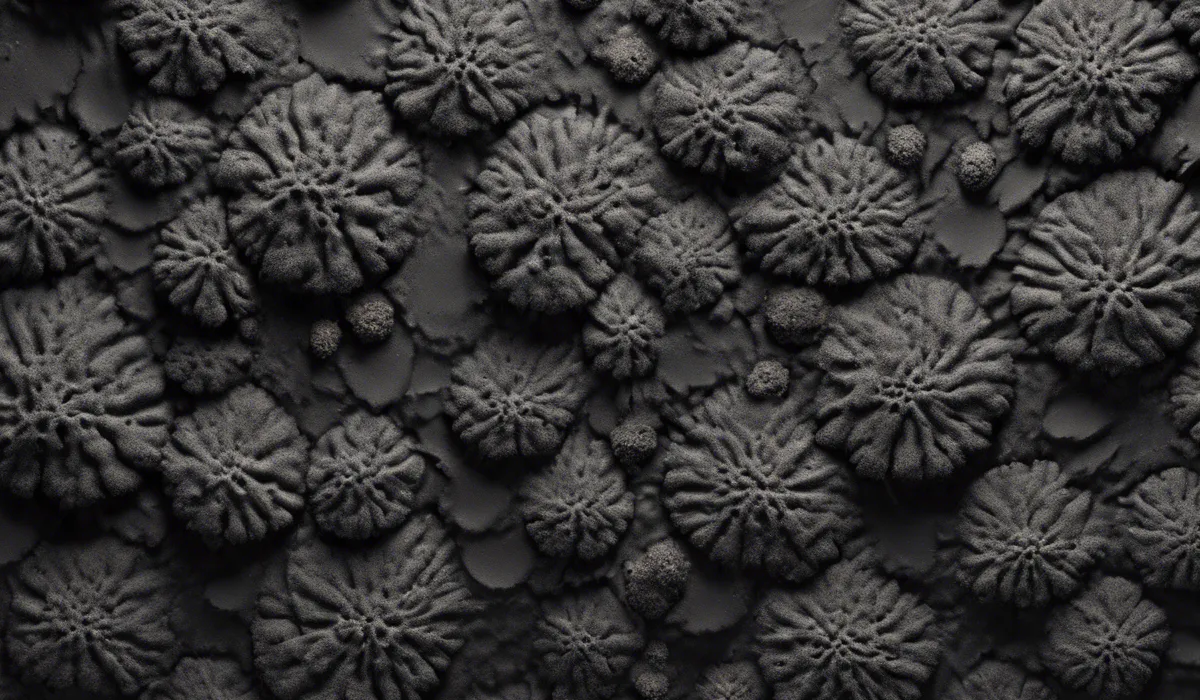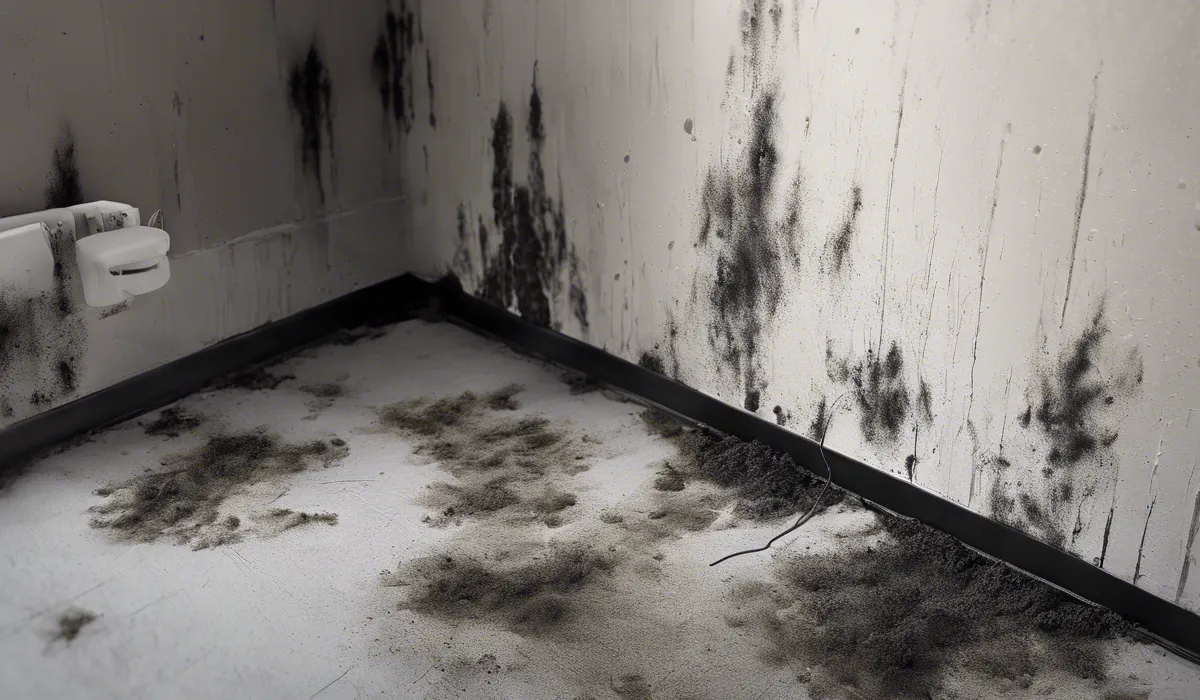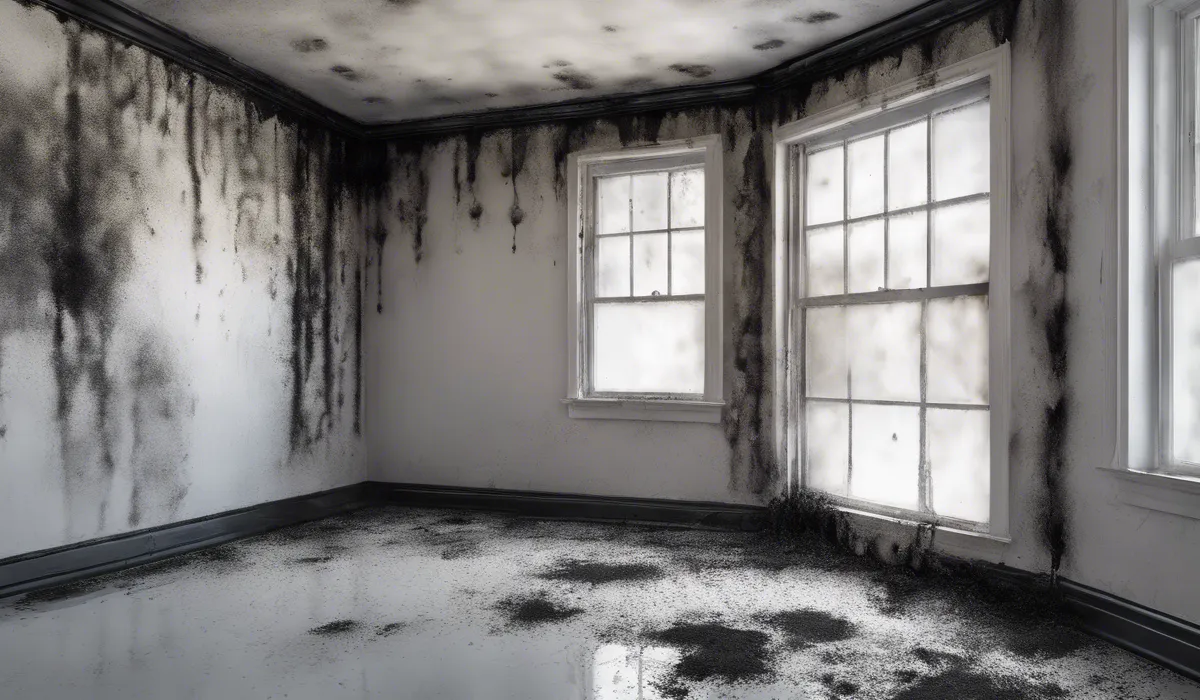Black mold typically grows within 24 to 48 hours in damp, warm conditions. It can become visible in 18-21 days. Growth rate depends on moisture level, temperature, and food source availability.
Understanding Black Mold and its Growth Cycle

Definition of Black Mold (Stachybotrys chartarum)
Black mold, known scientifically as Stachybotrys chartarum, is a type of fungus. It is famous for its dark color and ability to grow on damp surfaces.
This mold is not something you want in your home because it can cause health problems. It loves to grow on materials like paper, cardboard, and wood, especially when these materials are wet.
Conditions that Favor Black Mold Growth
Moisture
Moisture is like a welcome mat for black mold. When water leaks or floods happen, they create the perfect wet spots for mold to start growing.
Rooms with high humidity, like bathrooms and basements, are often where mold likes to hang out.
Temperature
Black mold grows best in warm places. It finds temperatures between 77 to 86 degrees Fahrenheit perfect. This is why mold can be a bigger problem in the summer or in warm climates.
Nutrient Sources
Like all living things, black mold needs food. It feeds on materials that have cellulose. Things like paper, wood, and natural fibers are like a buffet for black mold. These materials give it the nutrients it needs to grow and spread.
Darkness
Mold does not like sunlight. It prefers dark places where it can grow undisturbed. Closets, attics, and crawlspaces often become mold’s secret hideouts due to their lack of light.
Phases of Black Mold Growth
Spore Germination
Black mold starts its life as a spore, which is like a tiny seed. When the spore lands on a wet surface, it starts to grow.
This first step is called germination, and it’s when the spore wakes up and begins to turn into mold.
Mycelium Formation
After the spore germinates, it grows threads called hyphae. These threads spread out and weave together to form a network called mycelium. This network is what we see as mold on surfaces.
Spore Production
The final phase of black mold’s life cycle is making more spores. Once the mold has enough food and the right conditions, it starts to produce spores.
These spores can travel through the air to new places, starting the cycle all over again.
Factors Affecting the Growth Rate of Black Mold

Environmental Conditions and Their Impact on Growth Speed
Humidity Levels
Black mold grows faster when the air is full of moisture. High humidity makes surfaces damp, which is just what mold needs to spread. Keeping humidity low can slow down mold growth.
Ambient Temperatures
The temperature in a room can make mold grow faster or slower. Mold loves warmth, so turning down the heat can help control its growth. Cooler temperatures can slow down the mold’s life cycle.
Material Types
Mold grows quicker on certain materials. Organic materials that have cellulose, like paper and wood, are mold’s favorite. Keeping these materials dry and clean can help prevent mold from growing quickly.
Presence of Competing Microorganisms
Not all tiny life forms like mold. Some bacteria and other molds can actually fight with black mold for space and food. When these microorganisms are around, they can slow down the growth of black mold.
Effect of Ventilation and Airflow
Fresh air is not a friend to black mold. Good airflow helps keep surfaces dry and reduces humidity. This can make it harder for mold to grow. Using fans and opening windows can improve ventilation and protect against mold.
Water Incidents and Ongoing Dampness
Leaks, floods, and spills can all lead to mold growth. If these water problems are not fixed quickly, they can give mold the chance to start growing. It’s important to clean up water right away and keep things dry to prevent mold.
Timeline and Health Implications of Black Mold Exposure

Typical Timeline for Visible Mold Growth After Water Exposure
Black mold can start to grow in just 24 to 48 hours after something gets wet. It might take a few weeks to see the mold with your eyes. In about 18 to 21 days, mold can grow enough to be noticed on walls, ceilings, or other surfaces.
Stages of Growth and Spread Over Time
Mold begins as a spore and then grows into a network. Over time, it can cover more area and release new spores into the air. These spores can land in new places, making the mold problem bigger. Cleaning up mold early can stop it from spreading too much.
Health Risks Associated with Black Mold Exposure
Allergic Reactions and Respiratory Issues
Black mold can make people sneeze, cough, and have a stuffy nose. For some, it can make breathing hard or cause asthma to get worse. It is not good for anyone to breathe in mold, but it can be really bad for people with allergies or asthma.
Long-Term Health Effects
Being around mold for a long time can lead to more serious health problems. It can make people feel tired, give them headaches, and even affect their memory. That’s why it’s so important to get rid of mold and keep it from coming back.
Importance of Timely Mold Remediation and Prevention Measures
Getting rid of mold as soon as you find it is the best way to stay healthy. Using dehumidifiers, fixing leaks, and cleaning regularly can help prevent mold from growing.
If you have a lot of mold, you might need to call professionals to make sure it’s all gone and won’t come back.
FAQs About Black Mold Growth Rate
How quickly can black mold start to grow?
Black mold typically starts growing within 24 to 48 hours in damp and warm conditions.
When does black mold become visible to the naked eye?
Black mold can become visible in 18 to 21 days after it starts growing.
What factors influence the growth rate of black mold?
The growth rate of black mold depends on the moisture level, temperature, and availability of food sources.
Is it possible for black mold to grow faster than 24 hours?
While the typical growth starts within 24 to 48 hours, under optimal conditions it could potentially start growing slightly faster.
Can black mold growth be slowed down?
Yes, controlling moisture levels, reducing temperature, and removing food sources can slow down the growth of black mold.
Final Thoughts
Black mold growth initiates rapidly within 24 to 48 hours under suitable damp and warm conditions.
It typically takes 18-21 days to become visible to the naked eye. The rate of mold proliferation is contingent on factors such as the level of moisture, ambient temperature, and the presence of a viable food source for the mold spores to thrive on.
